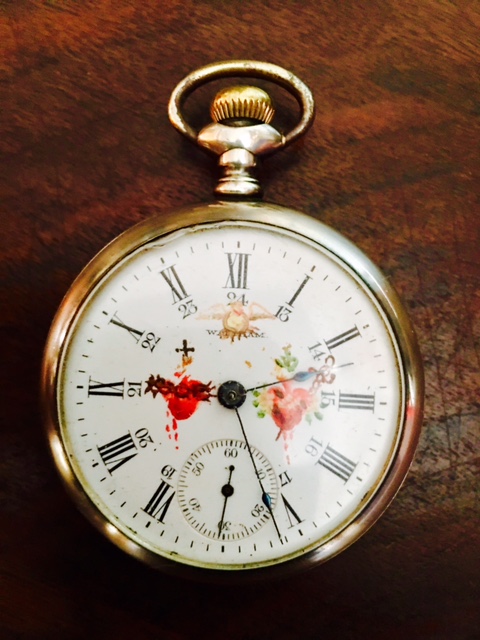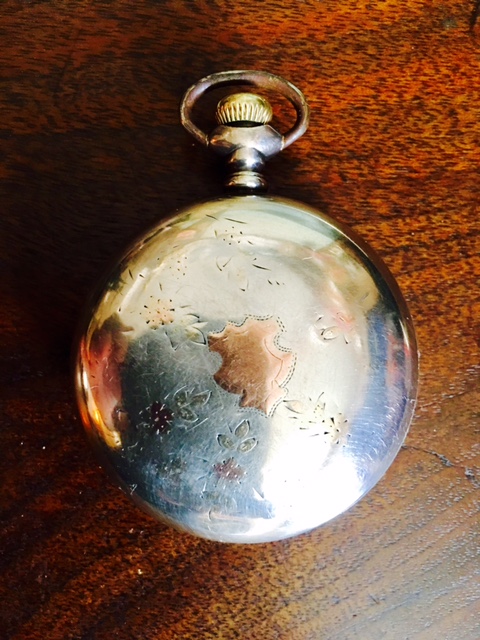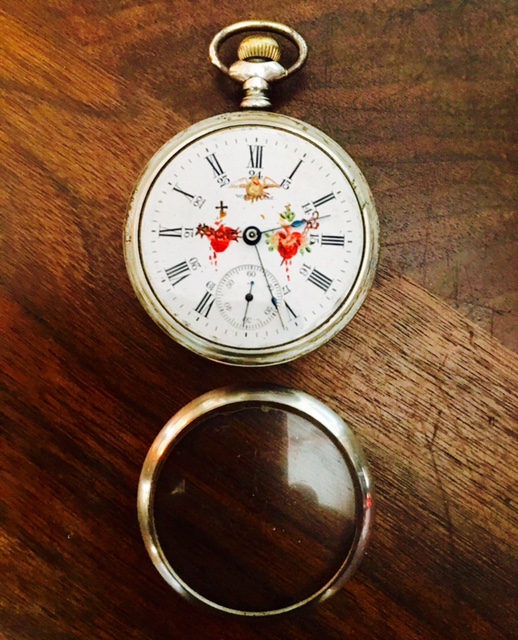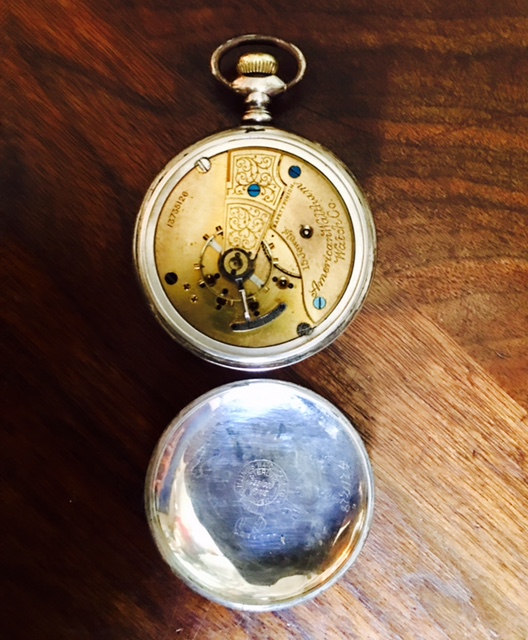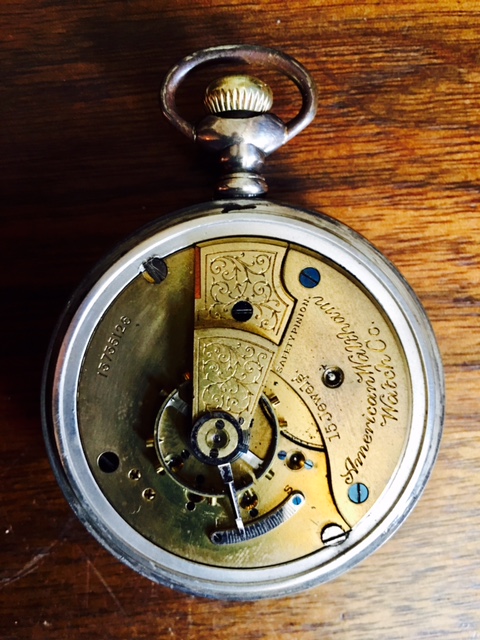Antique Pocket Watch 1900’s
Antique Pocket Watch 1900’s. Hand Painted detail: Two sacred Hearts ” Flying Dove”. Sterling Silver. Gold inlay.
Measures 2 inches circumference x 2 inches depth. “Illinois Watchcase Co. / Elgin Ill. / Sterling Fine Silver / 925/1000″
Serial numbers: #13735126 / 15 Jewels / American Waltham Watch Co.”
Engraved inside watch: Initials:”V.D.” (Victor Des-Roberts / my maternal grandfather).
Works perfectly. Mild chip in front glass.
VERBALLY APPRAISED AT $550
The following is very similar information found online:
| Manufacturer: | Waltham | |
| Manufacturer Location: | Waltham, Massachusetts | |
| Movement Serial Number: | 13735126 | |
| Grade: | No. 81 | |
| Model: | 1883 | |
| Estimated Production Year: | 1904 | |
| Run Quantity: | 4,000 | |
| Total Production: | 370,799 | |
| Size: | 18s | |
| Jewels: | 15j | |
| Jewel Setting: | Screw-Set | |
| Movement Configuration: | Openface | |
| Movement Finish: | Gilt | |
| Movement Setting: | Pendant | |
| Plate: | Full Plate | |
| Hairspring: | Breguet | |
| Adjusted: | No | |
| Railroad Grade: | No | |
| Data Research: | 1954 Waltham “Gray Book” List |
Brief History: American Waltham Watch Company
Including Waltham Watch Serial Numbers and Production Dates
Waltham, Massachusetts
1850 – 1957

The American Waltham watch factory on the banks of the Charles River.
The American Waltham Watch Company had its beginnings in 1850 in Roxbury, Massachusetts. The company was founded by David Davis, Aaron Dennison, and Edward Howard. Their vision was to form a watch company that could produce high-quality watches at a lower cost using interchangeable parts. With financial backing from Samuel Curtis, of small-arms manufacturing fame, the watch production began in 1851, and the first small group of watches were finished in late 1852. The first watches produced went to officials of the company, and it was not until 1853 that the first watches were offered for sale to the public.
Problems were encountered with the new production methods. The company was exploring innovative new ideas in watch manufacturing, such as using jewels, making enamel dials, and producing plates with a high-level of finish which required extensive tooling and resulted in a great financial burden. They also found that even though they were using interchangeable parts, each watch was still unique and had its own set of errors to be corrected. It took months to adjust the watches to the point where they were any better than other widely available timepieces.

Customer Department at the Waltham Watch Company.
In 1853, the factory building was completed and the company began doing business under the name “American Horologe Company.” The name was changed to “Boston Watch Company” in September 1853, and the factory in Waltham, Massachusetts was built in October 1854. The movements produced here (serial numbers 1001 – 5000) were signed “Dennison, Howard,& Davis,” “C. T. Parker,” and “P. S. Bartlett.”
The company went through a series of financial reorganizations and renamings over the next decades. The Boston Watch Company failed in 1857 and was sold at auction to Royal E. Robbins. It was reorganized as “Tracy, Baker & Co.” and later that same year the name was again changed to “Appleton, Tracy & Co” and watches 5001 – 14,000 were produced. The first movements carried the Appleton, Tracy & Co. marking. The C. T. Parker movement was reintroduced as the model 1857 and sold for $12, no small amount in those days!
Waltham During the Civil War Years
In January, 1859 the Waltham Improvement Co. and the Appleton, Tracy & Co. merged to form the “American Watch Company.”

The dial department of the Waltham Watch factory.
In 1860, as Abraham Lincoln was elected President and the country found itself in the throes of the Civil War, the American Watch Company was faced with serious financial problems. By 1861, business had come to a standstill and bankruptcy seemed inevitable. The factory was kept in operation through these years by cutting expenses to the lowest possible level… a strategy that proved successful.
According to the biography by Carl Sandburg, Abraham Lincoln owned and carried a Waltham “Wm. Ellery” watch. The watch was an 11-jewel, 18 size, key-wind in a silver hunter case, and was produced in January of 1863.
In 1885, the company became the “American Waltham Watch Company”. In 1865 prices for movements only (no case) were: William Ellery $13, P. S. Bartlett $16, Bartlett-Ladies $30, Appleton Tracy $38, A. T. & Co Ladies $40, and American Watch Grade $175!
In 1906 the company was renamed the “Waltham Watch Company”. In 1923, they became the “Waltham Watch and Clock Company” reflecting the new importance of clock manufacturing, but then in 1925 the name was changed back to “Waltham Watch Company”.
American Horology owes much to the brilliant visionaries of the Waltham Watch Company. Bacon, Church, Dennison, Fogg, Howard, Marsh, Webster, and Woerd all contributed greatly to American watchmaking.
Waltham continued to manufacture watches (and clocks) until 1957, when they ceased production and became the Waltham Precision Instrument Company. The rights to the name “Waltham Watch Company” were sold to the Hallmark Watch Company of Chicago, Illinois who continued to sell imported watches using the Waltham name. Several of the original Waltham factory buildings are still standing, and were added to the National Register of Historic Places in 1989.
Waltham Named Grades
In addition to using grade numbers, Waltham also used many grade names on their watches, often choosing the names of Board members, company investors, or other prominent individuals. The grade name basically designates the model and/or level of finish of the watch. Some of the more popular Waltham named grades were:
P. S. Bartlett, Appleton Tracy & Co., William Ellery, Crescent Street, Colonial, Riverside, Central Park, Broadway, Royal E. Robbins, Vanguard, Bond Street, Sterling, Premier, Royal, and Maximus.
Modern Waltham Watches
It is still possible to purchase modern quartz watches that bear the Waltham name, but these watches are unrelated to the “genuine” American Waltham Watch Company. In fact, a 1961 ruling by the Federal Trade Commission prohibited any inference that a relationship to the original Waltham Watch Company exists.

The bustling traffic outside the Waltham Watch factory at noon
